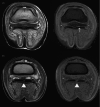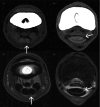Magnetic resonance imaging for diagnosing and managing deep digital flexor tendinopathy in equine athletes: Insights, advances and future directions
- PMID: 40314097
- PMCID: PMC12326952
- DOI: 10.1111/evj.14508
Magnetic resonance imaging for diagnosing and managing deep digital flexor tendinopathy in equine athletes: Insights, advances and future directions
Abstract
Deep digital flexor (DDF) tendinopathy is a significant cause of lameness and poor performance in equine athletes with substantial implications for their return to athletic performance. Magnetic resonance imaging (MRI) is increasingly integrated into the diagnostic workup of horses with foot pain and has revolutionised the diagnosis and management of these injuries. This review discusses the principles of MRI in the context of deep digital flexor tendon (DDFT) injury, comparing high-field and low-field systems and highlighting the clinical relevance of technical parameters, including field strength and sequence selection, in achieving an accurate diagnosis. This review also critically evaluates how different configurations and/or imaging features of tendon lesions may impact patient prognosis, considers the complementary role of computed tomography and ultrasonography in cases where MRI may not be feasible, and discusses emerging imaging techniques including positron emission tomography (PET)-MRI and quantitative MRI. Lastly, this review underscores the importance of serial imaging to monitor lesion progression and guide rehabilitation, while identifying knowledge gaps and proposing future research directions. Ultimately, a multidisciplinary approach incorporating advanced imaging and tailored rehabilitation is essential to improving clinical outcomes in horses with DDFT injuries.
Keywords: MRI; horse; tendinopathy; tendon.
© 2025 The Author(s). Equine Veterinary Journal published by John Wiley & Sons Ltd on behalf of EVJ Ltd.
Conflict of interest statement
The authors declare no conflicts of interest.
Figures






Similar articles
-
Equine flexor tendon imaging part 2: Current status and future directions in advanced diagnostic imaging, with focus on the deep digital flexor tendon.Vet J. 2021 Dec;278:105763. doi: 10.1016/j.tvjl.2021.105763. Epub 2021 Oct 19. Vet J. 2021. PMID: 34678501 Review.
-
Equine non-septic tenosynovitis: A systematic literature review of site-specific pathological lesions, outcomes and surgical complications.Equine Vet J. 2024 Sep;56(5):842-857. doi: 10.1111/evj.14000. Epub 2023 Sep 21. Equine Vet J. 2024. PMID: 37735927
-
Lameness in 46 horses associated with deep digital flexor tendonitis in the digit: diagnosis confirmed with magnetic resonance imaging.Equine Vet J. 2003 Nov;35(7):681-90. doi: 10.2746/042516403775696294. Equine Vet J. 2003. PMID: 14649360
-
Performance of Warmblood horses following tenoscopic desmotomy of the main part of the accessory ligament of the superficial digital flexor tendon for treatment of tendinopathy: 62 cases.Equine Vet J. 2025 Sep;57(5):1302-1312. doi: 10.1111/evj.14437. Epub 2024 Dec 5. Equine Vet J. 2025. PMID: 39639734
-
Clinical Updates on Superficial Digital Flexor Tendon Injuries: Insights on Diagnostic and Therapeutic Advancements.Vet Clin North Am Equine Pract. 2025 Aug;41(2):279-298. doi: 10.1016/j.cveq.2025.04.003. Vet Clin North Am Equine Pract. 2025. PMID: 40707073 Review.
References
-
- Ely ER, Avella CS, Price JS, Smith RKW, Wood JLN, Verheyen KLP. Descriptive epidemiology of fracture, tendon and suspensory ligament injuries in National Hunt racehorses in training. Equine Vet J. 2009;41:372–378. - PubMed
-
- Parkin TDH, Rogers K, Stirk A, et al. Risk factors for tendon strain injury during racing in Great Britain. Proceedings of the 16th International Conference of Racing Analysts and Veterinarians. Newmarket, UK: R and W Publications; 2006. p. 104.
-
- Williams RB, Harkins LS, Hammond CJ, Wood JL. Racehorse injuries, clinical problems and fatalities recorded on British racecourses from flat racing and National Hunt racing during 1996, 1997 and 1998. Equine Vet J. 2001;33:478–486. - PubMed
-
- Gutierrez‐Nibeyro SD, Werpy NM, Gold SJ, Olguin S, Schaeffer DJ. Standing MRI lesions of the distal interphalangeal joint and podotrochlear apparatus occur with a high frequency in warmblood horses. Vet Radiol Ultrasound. 2020;61:336–345. - PubMed
-
- Eliashar E, McGuigan MP, Wilson AM. Relationship of foot conformation and force applied to the navicular bone of sound horses at the trot. Equine Vet J. 2004;36:431–435. - PubMed
Publication types
MeSH terms
LinkOut - more resources
Full Text Sources
Medical

